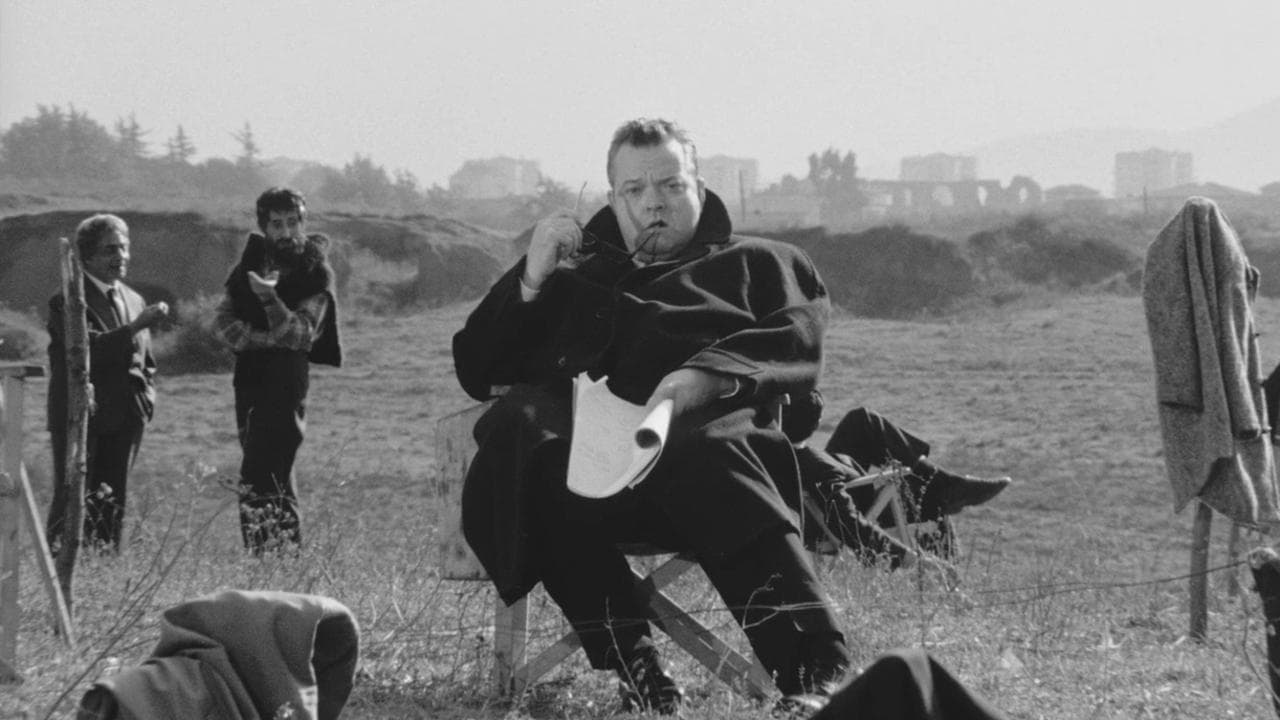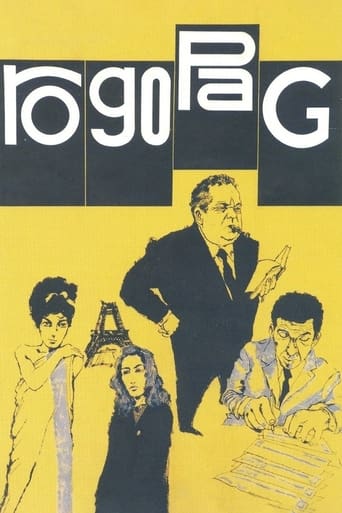

Ro.Go.Pa.G is an anthology consisting of four shorts by four of the greatest auteurs in the '60s: Rossellini (whose fame as a master director had already been recognized for at least ten years in the whole world), Godard (one of the fathers of the Nouvelle Vague and clear inspiration for the project as a whole, Pasolini and Gregoretti (at the time two "young" authors in search for glory). As the four segments were developed individually, I think that the best way to comment them would be to do so separately. "Illibatezza" by Roberto Rossellini. The story of an Alitalia hostess victim of what today we'd call a "stalker" who suffers from Oedipus complex. A simple, linear tale, although not immediately clear in its goal, in which the true star is the gorgeous Rosanna Schiaffino. In the American I can't help but see Rossellini's own sexual desire, probably participating in the act through his alter ego. Unfortunately Bruce Balaman (whose career counts only a couple of films) is not as captivating as the female lead, and the use of dubbing on the speaking actor makes things worse for him. It's interesting to note that Anna Maria admits to being obsessed with filming and taking pics of everything she experiences in everyday life, just like today's social networks invite us to do. This is a decisive cut from the author's Catholic phase and a change for the better, without ideological powers pressing on him. 8 "Il Nuovo Mondo" by Jean-Luc Godard. Godard never misses the chance to create something extremely unusual and destabilizing for the viewer, who is challenged to appreciate a language never before used in cinema. The short is about a possible future where an atomic bomb has been dropped near Paris and the psychological outcome this event has over the Parisiennes. The whole story is narrated in first person by the protagonist in voice over, which gives the feeling of reading a diary or a novel, except for a short dialogue between him and his lover (or, rather, "ex-lover"), whom appears to feel nothing anymore. Actually, the whole city "has changed", meaning that the fear of atomic destruction makes everyone's lives numb, with the help of some mysterious pill everybody seems to be taking. What Godard is showing us is the exact opposite of what we'd think a nuclear war would look like: apart from the screams and death of those directly hit by the bombs, everyone else would lose their interest in life, dragging a nihilistic existence, just like Alexandra does. Godard's signature features (jump cuts vs long takes) are there more than ever, with a beautiful fight between melancholy (underlined by the classical music) and raw truth (the fast cuts in the city). 8 "La ricotta" by Pier Paolo Pasolini. This is the most significant and historically important of the four films, so much that many consider this part more cinematically relevant than the whole container Ro.Go.Pa.G. Pasolini was sentenced to four months of reclusion for "contempt of the State religion", and the version we have public access to is a lot different than the original. It is a story about Stracci, a poor man working in the outskirts of Rome as an extra in a colossal about the Passion of Christ. Pasolini's message is very clear: we care more about the passion of the supposed son of God than of his sons'. Thus, while Stracci finally gets his desired meal, the saints in the movie laugh at him and cause his end. On the other hand, the characters of the director (Orson Welles!) and the journalist give out Pasolini's view of society, with the middle man being a "monstruosity" who doesn't understand deep thoughts but only his stupid, futile desires (like the dog). The film manages to be funny and extremely tragic at the same time, and the dycotomy between black-and-white actual world and colored fiction (and also between twist and classical music) explain through sensory experience the gap between reality and what show business wants us to believe. 9"Il pollo ruspante" by Ugo Gregoretti. Of the four, "Il pollo ruspante" is the least interesting short. It is a critique of post-war Italian society, after the economic boom that made the nation and its inhabitants much richer and caused the birth of a larger middle-class. The events are narrated through a commerce professor who speaks using a laryngophone (which somewhat dehumanizes him) and lived by a family of four led by the greatly funny Ugo Tognazzi. Although it has some smart moments, the message underlying lies too much on the surface, making it so explicit that becomes bothering, especially when the customers at the restaurant literally become battery-bred chicken. While the other directors managed to make their films secretly full of meaning, Gregoretti tries way too hard to make everyone in the audience understand everything. Still, Tognazzi is always a delight to watch, and the situations are too surreal to plainly hate them. 7Overall rating: 8
... View MoreRO.PO.PA.G, 1963. Been waiting for years to catch up with this Nouvelle Vague curiosity item somewhere -- and finally did at the Cinemathèque in Paris. This French-Italian production from 1963 is comprised of four episodes directed by four acclaimed European directors: Roberto Rossellini, Jean-Luc Godard, Pier Paolo Pasolini, and Ugo Gregoretti. Its short title, Ro.Go.Pa.G., borrows the initials of their names. This compendium Omnibus film by the four prestige authors, consists of four short films, in order: RO. Rosselini's 'Chastity' ('Illibatezza') -- GO. Godard's 'New World' ('Il Nuovo Mondo') -- . PA. Pasolini's 'Curd Cheese' ('La Ricotta') -- and G. Gregoretti's 'Free Range Chicken' ('Il Pollo Ruspante'). Viewed on Friday night Dec. 27, 2013 at the Cinémathèque. Overall, Rogopag was a big disappointment.Rosselini, Part 1, started out great examining the psychology of the in-flight crew on a long distance Alitaia Flight to Bangkok, but then got way out of hand with the story of a balding middle-aged nebbish stalking a good looking young Italian stewardess and some BS about the guy back home looking at the footage she shot in Thailand.PART 2. Pasolini, with a very pudgy faced Orson Welles in a guest shot directing a film about the crucifixion in some poor backward village. Villagers volunteer to appear as extras just to get some free food. This segment opens, in color with two guys doing a frenzied twist, and flips back and forth from color to Black and white --with speedup sequences, and a pudgy hapless zhlub on one of the other crosses. Had things to say but I basically didn't care for the Pasolini style-- Toot discombobulated for my taste. Part 3: The Godard installment with young Canadian actress Alexandra Stewart, was a big borathon, based on the ridiculous premise that an A-bomb exploded 160,000 km above Paris, was too high to harm the city but exerts a profound affect on the minds of the people below. Ridiculous. Finally, Part 4, the Ugo Grigoretti segment -- about chickens in a restaurant. A pompous father lectures to a boy about the difference between free range chickens and "elevated" ones ~ an obvious parallel to human society. Then it goes into a really boring extended section about trying to buy land but not having the money. About as lively as a real estate ad. All in all, Ropopag was a two hour disappointment but a necessary filler-in on the culture of the New Wave flooding the film world in the early sixties. FIVE stars out of ten for Half-assedness.
... View MoreRosselini's "Chastity" deals with an attractive air hostess who receives the unwelcome attentions of a middle aged American. Godard's "New World" illustrates a post-apocalypse world the same as the pre-apocalyptic one but for an enigmatic change in attitude in most people, including the central character's girlfriend. In Pasolini's "Curd Cheese", a lavish film about the life of Jesus Christ is being made in a poor area. The impoverished people subject themselves to various indignities in the name of movie-making in order to win a little food. The central character is hoisted up on a cross for filming, and dies there. Finally comes Gregoretti's "Free Range Chicken" in which a family of the materialist culture inadvertently illustrate the cynical, metallic voiced doctrine of a top sales theorist.If IMDb is to be believed, not too many people have actually seen this film. And I have to wonder why, when it has three or four of the biggest names in Italian cinema, not to mention Orson Welles. This makes a great introduction to Italian film for those who need such an introduction. Others have compared it to "Four Rooms", which is an interesting parallel. Stylistically, the two have nothing in common, but it does have that interesting approach of four different directors creating one film...
... View MoreIn all, RoGoPaG is not a great film, but Pier Paolo Pasolini's segment, "La ricotta", is one of the controversial Italian director's best film alogside his "Momma Roma", "Accatone", "Teorema", and (many others will disagree and appalled with this) "Salo". It works as a parody on Hollywood-styled religious epics, false religious faith, harsh life of the lower class, and revelation on the bitterness of life as an outsider (with Orson Welles playing a director and with his reading of Pasolini's poem from "Momma Roma" to a reporter who cared nothing but useless interviews). It's a multi-layered film, but is also enjoyable. (As a footnote, the segment was condemned by the Italian Catholic church and the entire film was held from release until the segment was edited slightly. It is not, however, in any way, blasphemous.)
... View More